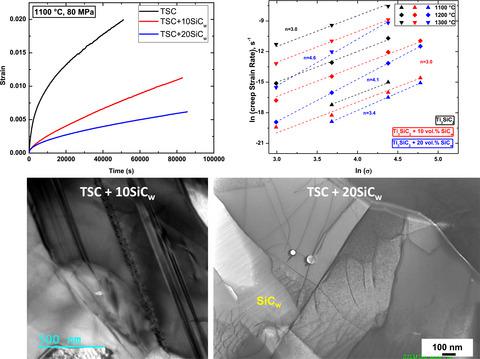当前位置:
X-MOL 学术
›
J. Am. Ceram. Soc.
›
论文详情
Our official English website, www.x-mol.net, welcomes your feedback! (Note: you will need to create a separate account there.)
Compressive creep of SiC whisker/Ti3SiC2 composites at high temperature in air
Journal of the American Ceramic Society ( IF 3.9 ) Pub Date : 2020-06-22 , DOI: 10.1111/jace.17323 Apurv Dash 1, 2 , Jürgen Malzbender 1 , Khushbu Dash 3 , Marcin Rasinski 1 , Robert Vaßen 1 , Olivier Guillon 1, 2, 4 , Jesus Gonzalez‐Julian 1, 2
Journal of the American Ceramic Society ( IF 3.9 ) Pub Date : 2020-06-22 , DOI: 10.1111/jace.17323 Apurv Dash 1, 2 , Jürgen Malzbender 1 , Khushbu Dash 3 , Marcin Rasinski 1 , Robert Vaßen 1 , Olivier Guillon 1, 2, 4 , Jesus Gonzalez‐Julian 1, 2
Affiliation

|
The compressive creep of a SiC whisker (SiCw) reinforced Ti3SiC2 MAX phase‐based ceramic matrix composites (CMCs) was studied in the temperature range 1100‐1300°C in air for a stress range 20‐120 MPa. Ti3SiC2 containing 0, 10, and 20 vol% of SiCw was sintered by spark plasma sintering (SPS) for subsequent creep tests. The creep rate of Ti3SiC2 decreased by around two orders of magnitude with every additional 10 vol% of SiCw. The main creep mechanisms of monolithic Ti3SiC2 and the 10% CMCs appeared to be the same, whereas for the 20% material, a different mechanism is indicated by changes in stress exponents. The creep rates of 20% composites tend to converge to that of 10% at higher stress. Viscoplastic and viscoelastic creep is believed to be the deformation mechanism for the CMCs, whereas monolithic Ti3SiC2 might have undergone only dislocation‐based deformation. The rate controlling creep is believed to be dislocation based for all the materials which is also supported by similar activation energies in the range 650‐700 kJ/mol.
中文翻译:

SiC晶须/ Ti3SiC2复合材料在空气中高温下的压缩蠕变
研究了SiC晶须(SiC w)增强的Ti 3 SiC 2 MAX相基陶瓷基复合材料(CMC)的压缩蠕变,温度范围为1100-1300°C,空气中的应力范围为20-120 MPa。通过火花等离子体烧结(SPS)烧结包含0、10和20体积%的SiC w的Ti 3 SiC 2,用于随后的蠕变测试。每增加10 vol%的SiC w,Ti 3 SiC 2的蠕变速率就会降低大约两个数量级。整体式Ti 3 SiC 2的主要蠕变机理而10%的CMC似乎是相同的,而对于20%的材料,应力指数的变化表明了不同的机理。在较高应力下,复合材料的蠕变速率为20%,趋于收敛到10%。粘塑性和粘弹性蠕变被认为是CMC的变形机制,而整体式Ti 3 SiC 2可能仅经历了基于位错的变形。速率控制蠕变被认为是基于所有材料的位错,并且还受到650-700 kJ / mol范围内的类似活化能的支持。
更新日期:2020-08-10
中文翻译:

SiC晶须/ Ti3SiC2复合材料在空气中高温下的压缩蠕变
研究了SiC晶须(SiC w)增强的Ti 3 SiC 2 MAX相基陶瓷基复合材料(CMC)的压缩蠕变,温度范围为1100-1300°C,空气中的应力范围为20-120 MPa。通过火花等离子体烧结(SPS)烧结包含0、10和20体积%的SiC w的Ti 3 SiC 2,用于随后的蠕变测试。每增加10 vol%的SiC w,Ti 3 SiC 2的蠕变速率就会降低大约两个数量级。整体式Ti 3 SiC 2的主要蠕变机理而10%的CMC似乎是相同的,而对于20%的材料,应力指数的变化表明了不同的机理。在较高应力下,复合材料的蠕变速率为20%,趋于收敛到10%。粘塑性和粘弹性蠕变被认为是CMC的变形机制,而整体式Ti 3 SiC 2可能仅经历了基于位错的变形。速率控制蠕变被认为是基于所有材料的位错,并且还受到650-700 kJ / mol范围内的类似活化能的支持。



























 京公网安备 11010802027423号
京公网安备 11010802027423号